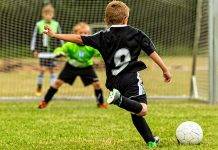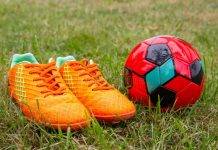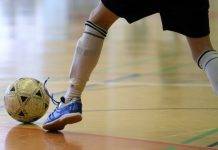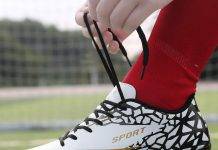When it comes to playing soccer, one might wonder if the choice of cleats truly makes a difference. After all, isn’t it just a matter of preference or fashion? However, as passionate soccer players ourselves, we can confidently say that the type of cleats you wear can greatly impact your performance on the field. From enhancing stability to improving traction, the right pair of cleats can give you that extra edge you need to score the winning goal. Join us as we explore the importance of selecting the right cleats for soccer and uncover the secrets to sprinting, stopping, and dominating the game.
What are soccer cleats?
Soccer cleats, also known as football boots, are specialized footwear designed specifically for the sport of soccer. They are an essential part of a soccer player’s gear and are specifically designed to provide traction, support, and enhance performance on the playing field.
Review contents
Definition and purpose
Soccer cleats are shoes that have small studs or spikes on the sole. These studs or spikes, commonly known as cleats, are strategically positioned to provide grip and stability on different playing surfaces. The primary purpose of soccer cleats is to prevent players from slipping or sliding while running, changing direction, and stopping suddenly during a game.
Different types of soccer cleats
There are various types of soccer cleats available, each designed to cater to different playing conditions and player preferences. Here are some of the most common types of soccer cleats:
-
Firm Ground (FG) Cleats: These are the most common type of soccer cleats and are designed for use on natural grass fields that are neither too soft nor too hard. They typically feature conical or bladed studs for optimal traction and stability on firm ground surfaces.
-
Soft Ground (SG) Cleats: SG cleats are designed for use on softer natural grass fields that may be wet, muddy, or have deeper grass. They usually feature longer metal studs that can penetrate the softer surface and provide enhanced traction.
-
Artificial Ground (AG) Cleats: AG cleats are specifically designed for use on artificial turf fields, which have different characteristics compared to natural grass. They typically have shorter, more numerous studs that provide better grip and stability on artificial surfaces.
-
Indoor Cleats: Indoor cleats, also known as futsal shoes, are designed for use in indoor soccer facilities or on hard court surfaces. They have a non-marking rubber sole that offers excellent grip and traction on smooth indoor surfaces.
-
Turf Cleats: Turf cleats, also called turf shoes or astro turf boots, are designed for use on artificial turf with a short, abrasive surface. They typically have small, rubber studs or patterns on the sole to provide traction without damaging the turf.
The importance of wearing proper soccer cleats
Wearing proper soccer cleats is of utmost importance for players at all levels of the game. Here are some key reasons why wearing the right cleats is essential:
Enhanced performance
Wearing the appropriate soccer cleats can significantly enhance a player’s performance on the field. The design and construction of cleats can provide better traction and grip, allowing players to make quick turns, accelerate faster, and improve their overall agility. With the right cleats, players can maximize their speed and mobility, giving them a competitive edge during matches.
Injury prevention
Wearing improper cleats can increase the risk of injuries during soccer games. The proper cleats provide the necessary support and stability to help prevent ankle sprains and other foot-related injuries. Additionally, cleats designed for specific playing surfaces can reduce the chances of slipping or getting the studs stuck in the ground, minimizing the risk of knee and leg injuries.
Traction and stability
One of the primary functions of soccer cleats is to provide traction and stability on different playing surfaces. The studs or spikes on the sole of the cleats grip into the ground, allowing players to maintain balance and control while making quick movements, changes in direction, or sudden stops. This traction and stability are crucial for players to perform at their best and reduce the risk of slips, falls, or loss of control during important game moments.
This image is property of www.aeares.com.
Factors to consider when choosing soccer cleats
Choosing the right soccer cleats involves considering various factors to ensure optimal performance and comfort. Here are some key factors to consider:
Playing surface
The playing surface is a crucial factor when selecting soccer cleats. Different surfaces require different types of cleats to maximize traction and performance. Consider whether you primarily play on firm natural grass, wet or muddy natural grass, artificial turf, or indoor surfaces to determine the most suitable cleat type.
Player position
The position you play on the soccer field can also impact your choice of cleats. Different positions require different movements and have varying demands regarding stability and control. For example, strikers and forwards may prioritize lightweight cleats with excellent responsiveness and traction, while defenders may opt for cleats with enhanced stability and protection.
Fit and comfort
Choosing properly fitting cleats is essential for comfort and performance. Ill-fitting cleats can cause discomfort, blisters, and even impact your agility and movement. Consider the width, length, and overall fit of the cleats to ensure they provide a snug yet comfortable feel.
Material and durability
Soccer cleats come in various materials, with leather and synthetic materials being the most common. Leather cleats offer excellent comfort, flexibility, and durability but may require more maintenance. Synthetic cleats, on the other hand, are often lighter, more water-resistant, and easier to clean. Consider the specific characteristics of each material to determine the best option for your needs.
The different types of soccer cleats
Understanding the different types of soccer cleats can help you make an informed decision when choosing the right pair for your playing style and field conditions. Here’s a breakdown of the various types of soccer cleats:
Firm Ground (FG) cleats
Firm ground cleats are the standard choice for most soccer players. They are designed for use on natural grass fields that are neither too soft nor too hard. FG cleats typically feature conical or bladed studs on the sole, providing excellent traction and stability on firm ground surfaces.
Soft Ground (SG) cleats
Soft ground cleats are specially designed for use on softer natural grass fields that may be wet, muddy, or have deeper grass. They usually have longer metal studs that can penetrate the softer surface and provide enhanced traction and grip.
Artificial Ground (AG) cleats
Artificial ground cleats are specifically designed for use on artificial turf fields. The unique characteristics of artificial turf require cleats with shorter, more numerous studs to provide optimal traction and stability. AG cleats can prevent injury and improve performance on these surfaces.
Indoor cleats
Indoor cleats, or futsal shoes, are designed for indoor soccer facilities or hard court surfaces. These cleats typically have a non-marking rubber sole, providing excellent grip and traction on smooth indoor surfaces.
Turf cleats
Turf cleats, also known as astro turf boots or turf shoes, are designed for use on artificial turf with a short, abrasive surface. These cleats usually have small, rubber studs or patterns on the sole to provide sufficient traction without damaging the turf.
This image is property of www.metroleague.org.
How playing surface affects cleat selection
The playing surface significantly affects the type of cleats that should be worn for optimal performance and safety. Here’s how different playing surfaces impact cleat selection:
Firm natural grass
For firm natural grass fields, such as well-maintained soccer pitches, firm ground (FG) cleats are the most suitable option. The conical or bladed studs on FG cleats provide excellent traction and stability on these surfaces, allowing players to make quick movements with confidence.
Wet or muddy natural grass
When playing on wet or muddy natural grass fields, soft ground (SG) cleats are the recommended choice. The longer metal studs on SG cleats can penetrate the soft, slippery surface, providing better traction and stability, minimizing the risk of slipping or losing control.
Artificial turf
Artificial turf fields require cleats specifically designed for this surface. AG cleats are designed with shorter, more numerous studs, ensuring maximum traction without damaging the turf. Opting for AG cleats on artificial turf can greatly improve performance and prevent unnecessary injuries.
Indoor surfaces
For indoor soccer facilities or hard court surfaces, indoor cleats or futsal shoes are the cleats of choice. Their non-marking rubber soles offer excellent grip and traction, allowing quick movements on the smooth indoor surface while protecting the court from damage.
The impact of player position on cleat choice
The position a player occupies on the soccer field can influence the choice of cleats. Different positions require specific movements and have varying demands, leading to different cleat preferences. Here’s how player position can impact cleat choice:
Strikers and forwards
Strikers and forwards often prioritize speed, agility, and acceleration. Lightweight cleats with excellent responsiveness and traction are generally preferred. Cleats with bladed studs or a combination of blade and conical studs can provide the necessary stability while allowing quick bursts of speed and changes in direction.
Midfielders
Midfielders cover a large portion of the field and require a balance between speed, agility, and stability. Cleats with a combination of conical and bladed studs can offer the necessary traction and support for midfielders. Additionally, mid-cut or high-cut cleats can provide additional ankle support during intense physical play.
Defenders
Defenders often need cleats that prioritize stability, protection, and durability. Cleats with a sturdy construction and reinforced upper materials can withstand rigorous play and provide enhanced protection against tackles and impacts. Cleats with bladed or conical studs offer a good balance between traction and stability.
Goalkeepers
Goalkeepers require cleats that prioritize stability, grip, and quick movements. Cleats with a wider sole and excellent traction can help goalkeepers maintain balance and make explosive dives or lateral movements. Lightweight cleats with bladed or conical studs are commonly preferred by goalkeepers.
This image is property of athleticlift.com.
Understanding the importance of fit and comfort
When it comes to soccer cleats, proper fit and comfort are crucial for performance and injury prevention. Here’s why fit and comfort matter:
Avoiding discomfort and blisters
Ill-fitting cleats can cause significant discomfort and even lead to blisters and other foot-related issues. Cleats that are too tight can cause pain and restrict movement, while those that are too loose can lead to instability and lack of control. Ensuring the cleats fit properly can help avoid these uncomfortable situations.
Proper sizing and width
Getting the right size and width of cleats is vital for overall comfort and performance. The cleats should neither be too tight nor too loose. They should provide a snug fit around the foot while allowing flexibility and natural movement. Trying on different cleats and considering individual foot characteristics can help determine the correct size and width.
Laceless vs. laced cleats
Laceless cleats have become increasingly popular in recent years due to their sleek design and glove-like fit. They rely on a tight synthetic upper to provide a secure fit without the need for laces. However, laced cleats offer more adjustability and customization, allowing players to fine-tune the fit according to their preferences. Choosing between laceless and laced cleats largely depends on personal preference and individual foot structure.
Material and durability considerations
The choice of material and durability of soccer cleats can impact their performance and longevity. Here are some important factors to consider:
Leather vs. synthetic materials
Soccer cleats can be made from either leather or synthetic materials. Leather cleats offer excellent comfort, flexibility, and durability. They mold to the foot over time, providing a custom fit. However, leather cleats may require more maintenance and may not be as lightweight as synthetic options. Synthetic cleats are often lighter, more water-resistant, and easier to clean. They provide a consistent fit and require minimal break-in time.
Water-resistant features
Playing in wet conditions can affect the performance and comfort of cleats. Some cleats come with water-resistant features, such as treated leather or specialized synthetic materials, to keep the feet dry. Water-resistant cleats can help maintain traction and prevent discomfort caused by water absorption.
Longevity and maintenance
Durability is an important factor to consider when choosing soccer cleats. Higher-quality cleats with sturdy construction and reinforced materials tend to last longer, especially with proper care and maintenance. Regular cleaning and proper storage can help extend the lifespan of the cleats, ensuring they remain in good condition for an extended period.
This image is property of www.soccerpro.com.
The impact of cleat choice on performance
The choice of soccer cleats can have a significant impact on a player’s performance. Here’s how selecting the appropriate cleats can enhance various aspects of the game:
Improved speed and agility
Cleats designed with lightweight materials and optimized traction can help players improve their speed and agility on the field. With the right cleats, players can make quick turns, accelerations, and changes in direction more efficiently, gaining a competitive edge over opponents.
Enhanced ball control
The proper traction and stability provided by soccer cleats can greatly enhance a player’s ball control skills. Cleats that allow for quick stops and precise movements can give players better control over the ball, enabling more accurate passes, dribbles, and feints.
Optimized shooting and striking
Soccer cleats with the right stud patterns and sole construction can improve shooting and striking capabilities. The stability and traction provided by the cleats can prevent slips or loss of balance during powerful shots, giving players more confidence and control over the ball.
Better stability and balance
An essential aspect of soccer is maintaining stability and balance while making quick movements. Cleats with well-designed studs can provide the necessary grip and stability to prevent slips and falls. This stability allows players to maintain control and execute movements with precision.
Conclusion
The significance of selecting appropriate soccer cleats cannot be overstated. The right cleats can greatly enhance a player’s performance, prevent injuries, and provide the necessary traction and stability on different playing surfaces. Factors such as the playing surface, player position, fit and comfort, material, and durability should all be considered when selecting soccer cleats. By choosing the right cleats, players can optimize their performance on the field, improve their skills, and enjoy a safer and more comfortable playing experience.
This image is property of ilovetowatchyouplay.com.










































